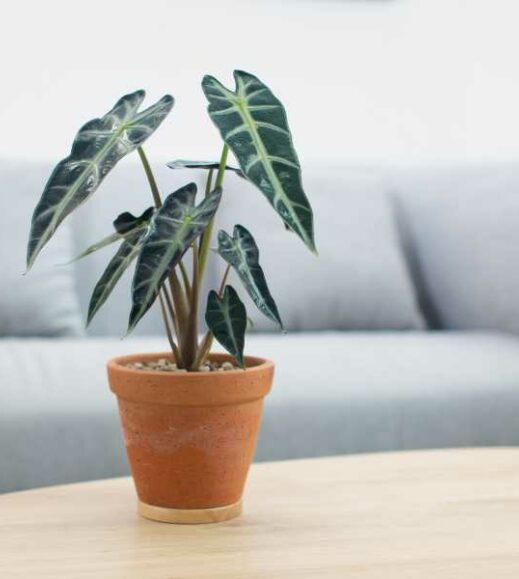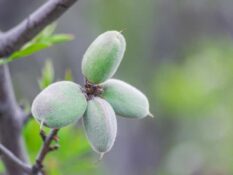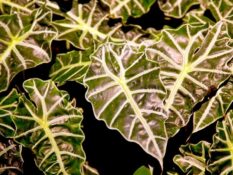Propagate | Soil | Light | Water | Temperature | Humidity | Potting | Pruning | Fertilize | Pest Control | FAQs
The Amazonian elephant's ear (Alocasia amazonica) plant is native to South America and belongs to the Araceae family. It originates from the tropical rainforest regions of Brazil, Ecuador, and Peru, where it grows in abundance.
This particular species of Alocasia has been cultivated for years by local gardeners for its large, waxy, heart-shaped foliage and striking appearance. It grows well in outdoor gardens and containers with sufficient sunlight exposure and proper soil/water conditions.
In addition to their unique leaf shape and vibrant colors, Amazonian elephant's ears also have a striking appearance due to their large size. These plants can easily reach heights of up to 3-5 feet, depending on the variety of plants you choose.
American Plant Exchange Alocasia Polly African Mask Amazon Shield Live Plant, 6" Pot, Eye Catching Indoor Air Purifier
One of the best things about growing an Amazonian elephant's ear is that it is extremely easy to care for. This plant adapts to various growing conditions and can thrive indoors and outdoors.
This guide will answer all common questions about growing, caring for, and maintaining this beautiful plant.
Do Amazonian elephant ear flower? What color is the Amazonian elephant's ear flower?
Amazonian elephant's ear plants will sometimes flower, although it is rare. The flowers are typically white or light green and bloom at the top of the plant near the leaves. The flower stalks can be anywhere from 18-36 inches in length, depending on the variety of plants you choose.
When to plant Amazonian elephant's ear plant?
The best time to plant an Amazonian elephant's ear is in the spring after all danger of frost has passed. Ideally, it would help to wait until nighttime temperatures are consistently above 50 degrees when planting outside.
Types of Amazonian elephant's ear: what are the recommended varieties of Amazonian elephant's ear plants?
There are several different varieties of Amazonian elephant ears that you can choose from. Some of the most popular options include:
Hilo Beauty: A beautiful, variegated variety of Amazonian elephant's ears with deep green leaves and golden-yellow edges. It is a striking plant and extremely easy to grow.
Aloha: This variety has large, heavily veined leaves that are glossy and dark green. The leaf margins also have a deep purple tinge, making the plant a gorgeous addition to any garden or container.
Cuna: This variety of Amazonian elephant's ears is one of the most striking, with large, heart-shaped leaves with gold and green venation. The plant also produces deep purple stems and burgundy flowers, making it a beautiful choice for any gardener.
Oahu: This compact variety of Amazonian elephant's ear is a great choice for gardeners who want richly colored foliage but don't have a lot of space. It has deep green leaves with bright pink veins, making it an eye-catching addition to any outdoor setting.
Illustris: This variety of Amazonian elephant's ear has extra-large green leaves with dark purple veins. It is known for producing large, bright white flowers on tall stalks and makes a stunning addition to any garden setting.
Amazonian elephant's ear soil requirements: What is the best soil for the Amazonian elephant's ear plants?
Amazonian elephant ear plants prefer well-drained soil rich in organic matter. When growing these plants, it is best to use a mixture of peat moss, compost, and perlite. You should also ensure that your soil has plenty of nutrients and minerals to keep your Amazonian elephant's ear healthy and strong.
Make sure to use healthy soil that is free of disease. Adding amendments and enhancers to the soil can help improve plant growth.
Amazonian elephant's ear light requirements: How much light does Amazonian elephant's ear plant need?
Amazonian elephant ear plants prefer bright, indirect sunlight and can thrive in both full sun and partial shade. If growing this plant outdoors, ensure it receives direct sun for only part of the day to prevent damage from excessive heat or light.
If you're looking to help your plants grow better under low light conditions, using plant grow light designed for specific plant wavelengths can improve growth.
Amazonian elephant's ear water requirements: How often to water the Amazonian elephant's ear plant?
When growing Amazonian elephant ear plants outdoors, they should be watered regularly, especially during summer. During the spring and fall, you can water your plants less frequently but keep them well-hydrated around the roots. Overwatering is much more common than underwatering with this plant, so it is important to pay attention to your plants and be careful with the amount of water you give them.
If you are growing an Amazonian elephant's ear indoors, it is important to keep the soil moist but not soggy at all times. You should also ensure that the area around your plants receives plenty of humidity to prevent wilting or other issues.
The frequency of watering depends on the season and the specific environment. To water your plants most effectively, choose an irrigation system that suits their needs.
Amazonian elephant's ear temperature range: What temperature can Amazonian elephant's ear tolerate?
Amazonian elephant's ear plants are hardy and can tolerate a wide range of temperatures, from warm summer days to cool, frosty winter nights. They prefer to be kept in temperatures between 50 and 70 degrees F, making them a great choice for gardeners in most regions of the United States.
If you need to keep your Amazonian elephant's ear plants in a more temperate or hotter environment, you can do a few things to help them adapt. For example, placing a fan near your plants or misting the leaves regularly can help increase air circulation and keep your plants cool.
Additionally, place a reflective material like tin foil around the plant pot to insulate your plant better and protect it from temperature extremes.
Be sure to take measures to protect plants during bad weather. You can use a greenhouse, cold frame, and plant protective covers to create a protected environment for your plant that will help keep it healthy and happy year-round.
Amazonian elephant's ear humidity: Do Amazonian elephant's ear like humidity?
Amazonian elephant's ear plants require a certain amount of humidity to thrive and grow properly. In drier environments, you can add a humidifier or mister to the area. If growing these plants indoors, ensure that your home is kept at a relatively high humidity level.
If you're growing an Amazonian elephant's ear outdoors, ensure that your plants receive plenty of water and sufficient humidity. You can also plant your Amazonian elephant's ear in an area that is shaded or partially shaded to reduce heat and increase humidity levels.
Several products help to maintain the humidity of plants around your Amazonian elephant's ear, including plant misters, plant pots with built-in reservoirs, and even grow lights that help provide a source of moisture. Just be sure to choose a product that best suits your plants and their needs.
Where to buy Amazonian elephant's ear plant?
Amazonian elephant ear plants can be found at many nurseries and garden centers. You can also order them online from a variety of online retailers. When looking for planting materials, look for plants that are healthy and free of pests or diseases. Always inspect the roots before purchasing your plant, and avoid any signs of rot or decay. Do your research beforehand to find reputable sellers with high-quality planting materials.
Amazonian elephant's ear plant propagation: How to propagate Amazonian elephant's ear plant?
Propagating plants is the process of creating new plants from existing ones. It's a great way to propagate your favorite varieties or save money by producing new plants for free. Several methods of growing new Amazonian elephant ear plants include cuttings, divisions, air layering, and seed germination.
Propagate Amazonian elephant's ear plant from seed
Amazonian elephant's ear plants can be propagated from seed. You'll need to collect the seeds once your plant has flowered and is ready for reproduction. To collect the seeds, gather them from the plant and place them in a paper bag or envelope at room temperature.
Once your seeds are fully dry and ready to plant, you can start the propagation process by gently pressing them into a seed starting mix or potting soil. The seeds should be planted only as deep as the thickness of the seed and then covered with a little more potting soil of seed starting mix.
Water the seeds regularly and place them in a warm, sunny location to allow them to germinate and grow into new plants.
Propagating Amazonian elephant's ear plant by cutting
Amazonian elephant's ear plants can also be propagated by taking a cutting from the plant. To do so, you'll need to wait until the plant is in its active growing season and has new growth.
To take a cutting, use a sharp pair of pruning shears to cut off the tip of a stem or leaf. Be sure to cut just above a node, where new growth will sprout from, and then place the cutting in a small container of water to allow the cut end to callus over.
Once the cutting has callused and developed a root system, you can transplant it into a larger container and grow it like any other Amazonian elephant's ear plant.
Propagating Amazonian elephant's ear plant through air layering
Another effective way to propagate Amazonian elephant's ear plants is through air layering, a process in which you cause a new plant to grow from the stem of an old one. To start air layering, you'll need to place a plastic bag over a section of the plant and then take a sharp knife to cut a ring of bark from the stem.
After you've created the ring around the stem and taken off a piece of the plant, you'll need to smear some rooting hormone along the newly-cut portion. Next, use some potting soil to pack it tightly into the hole created, and then wrap your cut part in a plastic bag.
Once you've sealed off the area and have allowed it to callus over, you can transfer the air-layered plant into a pot filled with soil and continue growing it as you would any other Amazonian elephant's ear plant.
Propagating Amazonian elephant's ear plant by division
The division is another method of propagating Amazonian elephant's ear plants. You'll need to dig up the plant and divide it into smaller, more manageable sections.
Be sure to dig up the entire plant and not just a small section of its roots when dividing it. Once you've split the plant into smaller pieces, allow each part to callus for a few days before transplanting them back into pots or the garden.
When done properly, these methods of propagating Amazonian elephant's ear plants are quick and effective ways to produce new plants from old ones. Make sure you choose the right time of year, and always start with good quality and healthy planting materials.
Potting Amazonian elephant's ear plant
Amazonian elephant's ear plants are best planted in large, well-draining containers filled with a loamy, sandy soil mixture. These plants will thrive when exposed to full sun, though they can also be grown in partial shade.
To pot your Amazonian elephant's ear plant, start digging a large enough hole in your soil to accommodate your plant's entire root system. When planting, be careful not to damage or break the roots in the process, and then backfill the hole and tamp down the soil around the plant.
Water your Amazonian elephant's ear plant regularly to keep the soil moist but not soggy. You can use a light fertilizer every three weeks to help your plant grow and thrive.
It is important to select the correct pot size or container for your Amazonian elephant's ear plant, as the container's size will significantly impact its growth and overall health. For best results, look for a container with ample drainage holes at the bottom and deep enough to accommodate the full size of your plant's root system.
How to prune Amazonian elephant's ear plant?
Pruning is an essential part of gardening, as it helps to maintain the health and shape of your plants. There are various pruning tools on the market, including pruners, loppers, saws, and pruning shears. This will help you avoid damaging the plant and reduce the risk of disease or pests.
Remove dead or damaged branches from the stems when pruning your Amazonian elephant's ear plant. You may also want to remove branches or stems growing in the wrong direction, as these can crowd out other parts of the plant.
Next, cut your Amazonian elephant's ear plant back to its desired height using sharp pruning shears. Depending on the size and shape of your plant, you should do this at the base of the plant or higher up on the stems.
Finally, seal any pruning cuts with a sealant or pruning wound dressing to help prevent disease and pests from entering the plant. If your cut is particularly large, add a layer of mulch around the base of your plant for extra protection.
Overall, pruning is important in caring for your Amazonian elephant's ear plant. Following these simple tips ensures that your plant stays healthy and grows beautifully over time.
How to fertilize Amazonian elephant's ear plant?
Amazonian elephant's ear plants require regular fertilization to thrive and produce healthy foliage. There are many different types of fertilizer available on the market, so you can choose the one that is right for your specific plant and growing conditions.
When fertilizing an Amazonian elephant's ear plant, add a light layer of fertilizer to the soil around your plants. You can apply it directly to the soil or use a slow-release fertilizer, which will break down more slowly and give your plants a sustained supply of nutrients.
You should fertilize your Amazonian elephant's ear plant at least once a month or more if necessary. It is also important to ensure that your fertilizer contains nutrients for your specific plant, such as nitrogen, potassium, and phosphorus.
Choose a high-quality fertilizer with a balanced NPK (nitrogen, phosphorus, and potassium) ratio to fertilize your Amazonian elephant's ear. Some of the plants also benefit by adding appropriate soil amendments.
Common Amazonian elephant's ear diseases and how to manage Amazonian elephant's ear disease?
Amazonian elephant's ear plant is prone to a few common pests and diseases, including:
Aphids: Aphids are small, sucking insects that can cause serious damage to your plants. They tend to attack the leaves and stems of your plant, feeding on the sap and juices. To manage aphids, try regularly spraying your plant with a strong jet of water to remove them from the leaves and stems. You can also apply an insecticidal soap to your plants or use a systemic pesticide to help control the aphids over time.
Scale: Scale is a common pest that causes damage to the stems and leaves of your Amazonian elephant's ear plant. This small insect can be difficult to treat, as it can hide under the leaves and stems of your plant. To manage scale, try spraying your plant with insecticidal soap or horticultural oil to kill the insects. Consider using a systemic pesticide, which will help control the scale over time.
Bacterial leaf spot: Bacterial leaf spot is a common problem in Amazonian elephant's ear plants, and it can cause lesions and spots on the leaves and stems. To manage bacterial leaf spot, try pruning any affected parts of your plant, and increase your plant's air circulation by regularly pruning. You may also want to use a fungicide spray or systemic pesticide to help control this disease.
Taking good care of your Amazonian elephant's ear plant is key to keeping it healthy and free from pests and diseases. Make sure you are watering your plant regularly, providing it with plenty of sunlight, and monitoring for signs of stress or damage. Additionally, practice good garden hygiene by removing any diseased leaves or debris, and take advantage of natural pest control methods whenever possible. Use good quality insecticides and fungicides if there is an outbreak of disease or pests. Always follow the instructions carefully to minimize any potential harm to your plants.
Takeaway on how to grow and care for Amazonian elephant's ear plant
To grow and care for an Amazonian elephant's ear plant, it is important to provide plenty of sunlight, regular watering, and good air circulation. Additionally, you should monitor your plants regularly for signs of pests and disease and take steps to manage these problems as they arise. This may include using insecticides and fungicides, pruning affected leaves or debris, or increasing air circulation by regularly pruning your plant. With proper care and attention, your Amazonian elephant's ear plant will thrive and deliver beautiful flowers and lush foliage for many years.
If you want to add some more plants to your garden, explore our plant grow and care guides collection.
If you're new to gardening or a seasoned pro, join our supportive AgFunnel community of gardeners. Share a picture of your garden and receive support from fellow plant lovers.
Happy gardening!

How to master gardening? Download these essential home and gardening ebooks today!
FAQs
What is Amazonian elephant's ear?
The amazonian elephant's ear is a beautiful flowering plant native to South America. It has large, distinctive leaves and produces lovely pink, purple, and white flowers.
Where to put Amazonian elephant's ear?
Amazonian elephant's ear can be grown in a wide range of climates, and it does well when planted in full sun or partial shade. To ensure optimal growth, choose a location for your plant with plenty of space and good soil quality.
How often should Amazonian elephant's ear be watered?
Amazonian elephant's ear should be watered regularly, with the amount varying depending on factors such as temperature and soil type. To determine whether or not your plant needs water, stick your finger into the soil to check its moisture levels. If your plant is dry to the touch, you may want to water it, but be careful not to overwater.
How to get Amazonian elephant's ear to bloom?
To encourage blooming in your Amazonian elephant's ear plant, ensure you provide it with lots of bright sunlight and well-draining, moist soil. Consider using a plant food or fertilizer specifically formulated for flowering plants.
Does Amazonian elephant's ear plant like sun or shade?
Amazonian elephant's ear plant does well in full sun, partial shade, or even full shade. However, it will produce the most blooms and lush green foliage in sunny conditions. Additionally, ensure to water your plant regularly, no matter its location, as lack of moisture can cause leaves to wilt or fall off.
Is the Amazonian elephant's ear plant annual or perennial?
Amazonian elephant's ear plant is considered annual, though it can be easily propagated and maintained as a perennial. With proper care and attention, your plant will continue to produce blooms year after year.
Does the Amazonian elephant's ear plant come back every year?
Yes, the Amazonian elephant's ear plant will come back every year. Consistent care and attention can produce lush foliage and beautiful flowers for many years. To ensure your plant thrives, keep it in a sunny location with well-drained soil and regular watering. Additionally, monitor your plant for pests or diseases and take steps to manage these issues as they arise. Finally, consider using fertilizer or plant food specifically formulated for flowering plants to help encourage vigorous growth.
Are Amazonian elephant's ear plants toxic to cats?
Yes, Amazonian elephant's ear plants can be toxic to cats. If your cat has come in contact with one of these plants and is exhibiting signs of illness, such as vomiting or diarrhea, take it to the vet immediately for treatment. To prevent your cat from ingesting a toxic plant, keep your Amazonian elephant's ear plant in an inaccessible area to your pet. Consider using a wire or other barrier to protect your plant from curious cats.
Are Amazonian elephant's ear plants toxic to dogs?
Yes, Amazonian elephant's ear plants can be toxic to dogs. If your dog has come in contact with one of these plants and is exhibiting signs of illness, such as drooling or vomiting, take it to the vet immediately for treatment. To prevent your dog from ingesting a toxic plant, keep your Amazonian elephant's ear plant inaccessible to your pet. Additionally, consider using a barrier or other method to keep your pet out of the area, as well as houseplant and a toxic plant food or fertilizer to complement your Amazonian elephant's ear plant.
Are Amazonian elephant's ear plants toxic to pets?
Yes, Amazonian elephant's ear plants can be toxic to pets. If your pet has come in contact with one of these plants and is exhibiting signs of illness, such as drooling or vomiting, take it to the vet immediately for treatment. To prevent your pet from ingesting a toxic plant, be sure to keep your Amazonian elephant's ear plant in an area that is inaccessible to your pet. Additionally, consider using a barrier or other method to keep your pet out of the area, as well as houseplant and a toxic plant food or fertilizer to complement your Amazonian elephant's ear plant.
How cold can Amazonian elephant's ear plants tolerate?
Amazonian elephant's ear plants can tolerate cold temperatures down to about 40 degrees Fahrenheit. To keep your plant looking its best, be sure to protect it from freezing temperatures by bringing it indoors if you live in a region where the temperature regularly drops below 40 degrees Fahrenheit. Additionally, cover your plant if it is exposed to heavy rain and wind, which can damage or even knock over your plant.
How often to water the Amazonian elephant's ear plant?
In general, Amazonian elephant's ear plants require about 1-2 inches of water per week. However, how much you need to water your plant will depend on your climate, soil type, and plant size. To determine how much water to give your Amazonian elephant's ear plant, check the soil around your plant regularly and water only when it is dry an inch below the surface. Additionally, adjust your watering schedule based on the weather and season, as over-watering or under-watering your plant can lead to health problems.
When to stop watering the Amazonian elephant's ear plant?
The best time to stop watering your Amazonian elephant's ear plant will depend on the climate and season in which you are located. In general, plants will require less water as the temperature cools, and you should stop watering altogether during the winter months. If you are still determining how much to water your plant, check the soil around it regularly and water only when it is dry an inch below the surface. Additionally, adjust your watering schedule based on the weather and season, as over-watering or under-watering your plant can lead to health problems.
Are Amazonian Elephant's Ear Plants and Alocasia Plants the Same?
Yes, Amazonian Elephant's Ear Plants and Alocasia Plants are the same. They both fall under the Alocasia genus and require similar care. Proper alocasia elephant ear care includes providing adequate sunlight, watering, and well-draining soil to thrive. Remember to keep the plant away from direct sunlight to prevent scorching.
When to fertilize Amazonian elephant's ear plant?
In general, you should fertilize your Amazonian elephant's ear plant in the spring and early summer to encourage new growth. To fertilize your plant, use a water-soluble fertilizer with a low concentration, such as 10-10-10. When fertilizing your plant, make sure that the fertilizer is distributed evenly around the base of your plant, and avoid getting any fertilizer on the leaves, as this can burn them. Additionally, be sure to fertilize your plant less often in the fall and winter, as only a little growth will likely occur.












